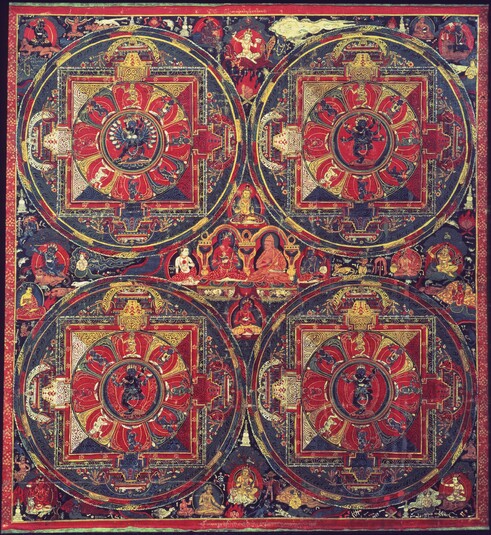
Item: Mandala of Hevajra (Buddhist Deity)
| Origin Location | Tibet |
|---|---|
| Date Range | 1500 - 1599 |
| Lineages | Sakya, Ngor (Sakya) and Buddhist |
| Material | Ground Mineral Pigment on Cotton |
| Collection | Private |
Classification: Deity
Four mandalas in a single composition from a set of paintings depicting the mandalas of the Vajravali of Abhayakara Gupta (10th. century). The full set of paintings were commissioned by the 13th Ngor Khenpo Drangti Namkha Palzang (1532-1602) [TBRC P777] and were created to commemorate the death of the 11th Ngor Khenpo, head of the Ngor sub-school, Sanggye Sengge (1504-1569) [TBRC P2510]. The paintings have to have been made after the death of Sanggye Sengge and even up to several years after. Therefore the date of the creation should properly be between 1569 and likely 1575 at the latest. At least two other paintings are known to exist from this set.
At the center of the composition is the red female deity Jnana Dakini seated on the left. Seated to the right side of the center is Abhayakara Gupta dressed as a monk and wearing a pandita hat.
The four mandalas are all for the same basic subject of the meditational deity Hevajra and consort Vajra Nairatmya as described in the Hevajra Tantra text. The mandalas have at the center four different forms of the deity. At the top left is an eight-faced sixteen-armed Hevajra. On the left is a three-faced six-armed Hevajra. At the bottom left is one-faced four-armed Hevajra and on the right is one-faced two-armed Hevajra. The four mandalas represent the highlighted human and Tantric aspects of body, speech, mind and essence.
In the four directions and the four intermediate directions are elements and scenes of the Eight Great Charnal Grounds (Cemeteries). These eight are features only of wrathful and semi-wrathful mandalas. Peaceful mandalas such as Guhyasamaja and Medicine Buddha have no surrounding cemeteries.
From the Hevajra Tantra literature: "In the east is the Gruesome charnel ground (chandograkatasi); south Frightful with Skulls (bhairavakapalika); west Adorned with a Blazing Garland (jvalamalalankara); north Dense Jungle (girigahvaronnati); north-east Fiercely Resounding (ugropanyasa); south-east Forest of the Lord (ishvaravana); south-west Dark and Terrible (bhairavandhakara); north-west Resounding with the Cries Kili Kili (Kilikilaghoshanadita). Furthermore, there are headless corpses, hanging corpses, lying corpses, stake-impaled corpses, heads, skeletons, jackals, crows, owls, vultures, and zombies making the sound, "phaim". There are also siddha with clear understanding, yaksha, raksha, preta, flesh eaters, lunatics, bhairava, daka, dakini, ponds, fires, stupa, and sadhaka. All of these fill the charnel grounds." (Konchog Lhundrub 1497-1557, written in 1551). (See painted example). (See Charnel Ground).
In the Tantric Buddhist classification of Anuttarayoga, according to one system, the Eight Direction Gods of the Cemeteries are: 1. east Shakra on an elephant, 2. south Yama on a buffalo, 3. west Varuna on a makara, 4. north Yaksha on a horse, 5. north-east Ishana on a bull, 6. south-east Agni on a goat, 7. south-west Rakshasa on a zombie, 8. north-west Vayu on a deer.
Jeff Watt 11-2010
Numbered List:
A. Hridaya Shri Hevajra (Essence)
B. Chitta Hevajra (Mind)
C. Vak Hevajra (Speech)
D. Kaya Hevajra (Body)
E. Jnana Dakini
F. Abhayakara Gupta (Indian Scholar)
Eight Cemeteries Direction & Eight Gods:
1. South-west, Rakshasa on a zombie
2. West, Varuna on a makara
3. North-west, Vayu on a deer
4. North, Yaksha on a horse
5. North-east, Ishana on a deer
6. East, Shakra on an elephant
7. South-east, Agni on a goat
8. South, Yama on a buffalo
(The enumeration of the cemeteries traditionally begins with the Eastern direction as do most elements contained in the mandala).
Publication: Tibet, Tradition & Change
Thematic Sets
Subject: Vajravali Main Page
Subject: Greyscale - Figurative & General Composition
Painting Set: Vajravali (Drangti Namkha Palzang)
Subject: Vajravali Painting Set Page
Publication: Tibet, Tradition & Change (Painting)
Buddhist Deity: Hevajra Mandala (Masterworks)
Mandala: Four Mandala Composition
Collection: Private 22


